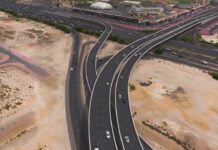Source: www.ameinfo.com
Infrastructure projects such as ports, power plants or roads and bridges are mushrooming in the six countries of the Gulf Cooperation Council as they deal with rapidly growing populations and their ambitions to link Europe and East Asia economically. The integration of individual projects and providing alternative means of financing will be hot topics from 2010 onwards.

The global financial crisis has not kept the GCC away from moving ahead with its infrastructure projects. “Delays due to the global recession in 2009 were overall minor”, says Frank Beckers, Managing Director of Project and Capital Advisory Middle East, Africa and Asia at Deutsche Bank in Dubai. The GCC‘s total population is nearing 40 million people, with population growth averaging 3.4% during the last four years.
According to the IMF, total GCC medium-term project investment stood at $2,193bn in 2009. Of this 44% are real estate projects while infrastructure, oil and gas each account for 19%. In the country breakdown The UAE and Saudi Arabia lead in the GCC with 41.8% and 28.8% of investment respectively.
“The next step will be to integrate these projects”, says Dr. Nasser Saidi, Chief Economist of the DIFC Authority in Dubai. Dubai has some 18 plus free zones covering most industrial sectors, but most of the zones became isolated clusters and are barely linked to the emirate’s public transport network. The start of the 52.1 kilometre long Dubai Metro on September 9 2009 was a first step in integrating the free zones and providing low-carbon means of transportation.
Beside staples such as hospitals, pipelines, public transport systems or schools, the UAE has also set up an Energy and Environment Park in Dubai and the zero-carbon-city Masdar clusters (both under construction) in order to produce clean electricity, create efficient waste energy schemes and to attract alternative energy producers from abroad.
Green technology financing
“The green shoots of innovation have to become a real market in regards to technology, delivery and financing”, Adil Marghub, Manager of Infrastructure and Energy for the International Finance Corporation, the investment arm of the World Bank, explains.
According to Marghub, the high use of water is one of the main obstacles the GCC faces when transforming itself from a primarily carbon energy producing region to a diversified economic block. The Middle East and North Africa is the only region in the world where withdrawals exceed renewable resources with a whopping annual withdrawal of 121% of existing resources (compared to around 5% in Europe and Central Asia).
Financing environmentally friendly projects, however, is not the burden. “The liquidity is there”, says Deutsche Bank’s Frank Beckers. “The Middle East uses project finance as a dominant funding strategy for infrastructure projects. Some 57% of the $396bn Middle Eastern projects completed between 2006 and 2009 were financed with loans and bonds compared to 5% globally.” Qatar, for example, can finance its recently announced $25bn railway project, of which Germany’s railway monopolist Deutsche Bahn AG holds 49% stake, alone.
“But in 2009, the GCC states started to transform their financing risks by tapping new means of fund sources”, Beckers explains. Among these are Public Private Partnerships, Islamic Bonds (Sukuk) and Private Equity funds. Frank Beckers: “In 2009, the issuance of a $750m Eurobond for Abu Dhabi-based Dolphin Energy and the $530m additional Islamic financing of Qatargas II demonstrated that there is a market for the non-loan segment.”
Recent developments are encouraging. Adil Marghub: “On November 3 IFC issued a $100m five-year Sukuk and listed it on the Nasdaq Dubai and the Bahrain Stock Exchange. We are keen on developing a Sukuk market in the Middle East, where our annual investment portfolio is about $4bn”.



















